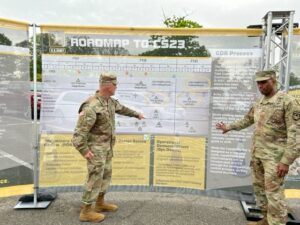After wrapping up the critical design review (CDR) last week for its Capability Set (CS) 2023 network modernization capability drop, officials said the Army will run upcoming operational demonstrations with soldiers in Europe to inform final fielding decisions in the second quarter of next fiscal year.
Officials leading the Army’s network modernization initiative detailed CS 23 during the CDR media event at Fort Myer in Virginia last week, noting the effort is focused on providing improve on-the-move network capability to Stryker brigades, bringing in new electronic warfare (EW) and cyber capabilities and setting the foundation for a new “tactical data fabric.”

“Going from [CS] 21 to 23, we went from dismounted to mounted. That was probably one big fundamental change. We were looking at brigades for CS 21. We’re now starting to look at divisions as the unit of action. We’ve also added a whole lot of enablers, not just the traditional stuff. So we now have intel, electronic warfare, some soldier aspects. And last but probably most important is the JADC2 component, the data and interoperability and working with our coalition partners,” Maj. Gen. Rob Collins, program executive officer for command, control and communications-tactical, told reporters.
The Army is currently working through two-year capability drops to transform its tactical network, with Collins noting the first effort, CS 21, is about 70 percent through fielding with plans to have that completed by the end of FY ‘22.
“We are pushing [CS 21 capability] out to a predominant amount of our infantry formations,” Collins said during a discussion at a recent C4ISRNET virtual event. “That’s really where we focus in on a lot of our expeditionary capability and focus in on assisting with ease of use for our lower tactical formations.”
Officials told reporters CS 23 builds on the foundation of CS 21, which focused on providing infantry units and dismounted soldiers with new network connectivity equipment, radios, and SATCOM capabilities.
Units with the Army’s 2nd Cavalry Regiment based in Germany will continue to receive a representative set of equipment from the CS 23 portfolio, according to Collins, who will then work through an initial operational demo in June and a second event around January 2023 to inform final fielding decisions.
“We’ll gradually increase not only in scale but also in the operational missions. We’re making sure we can be flexible to the operational unit, fitting in with their already-planned set of mission training,” Collins said.
Building out CS 23 has included broadening the network capability set construct to now include contributions from five Army program executive offices, four of the modernization-focused Cross-Functional Teams and more than 10 individual project manager offices, according to officials.
On the EW pieces of CS 23, Collins noted this has included a planning management tool to give units situational awareness and common operational picture of the electromagnetic spectrum as well as furthering work on the Terrestrial Layer System program to combine SIGINT, cyber tools, EW sensing and non-kinetic effects capabilities onto some Strykers.
The Army is also introducing the idea of a “tactical data fabric” with CS 23 as it works to build out a system of capabilities that can support the management and transfer of critical data on the battlefield, to include assessing ongoing cloud efforts and bringing in programs such as Army Cyber Command’s Gabriel Nimbus big data platform.
CS 23 also includes rolling out design enhancements for the new Command Post Computing Environment, such as adding a cyber situational understanding application, and moving ahead with plans to field five brigade sets of new mobile command posts.
The Army is planning to host a technical exchange meeting with industry in Philadelphia on May 9 and 10 to discuss network design goals for CS 25 and 27.
“That’s so we can start to look at the types of industry investments, the type of science and technology areas that we want to focus in on so we can start to get after that continuous modernization and initiative,” Collins said at the recent C4ISRNET event. “It allows industry to give us feedback so that we can take into consideration not only where there are gaps but where there are industry solutions to be able to address some of those areas that we want to focus in on.”